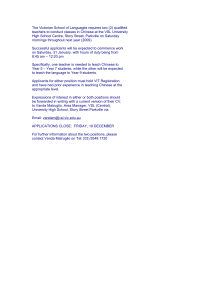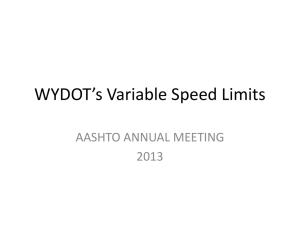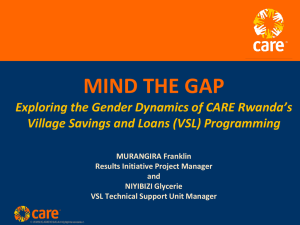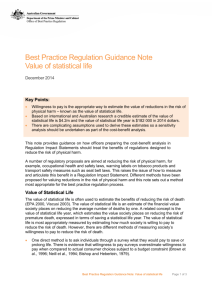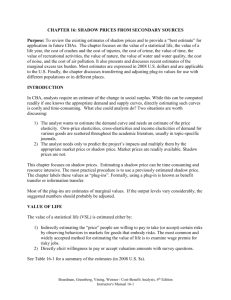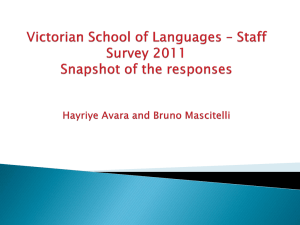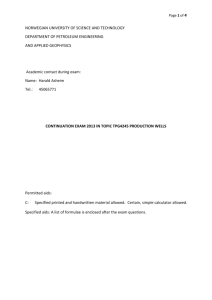Deriving Values of Statistical Lives from Behaviour Jon Strand
advertisement
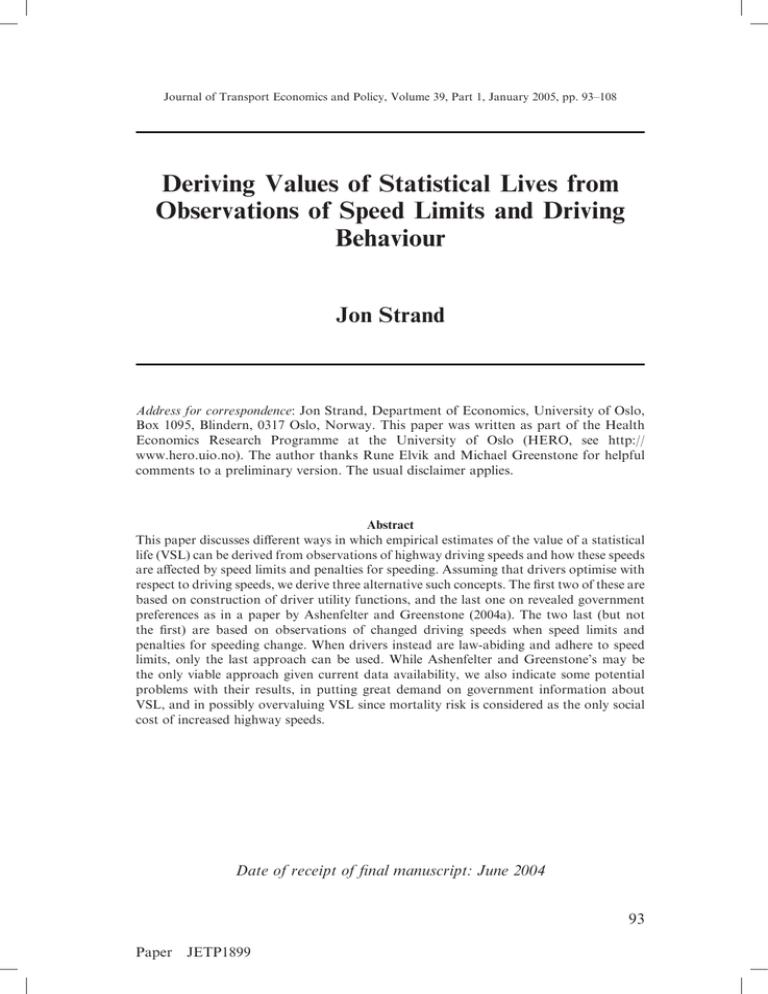
Journal of Transport Economics and Policy, Volume 39, Part 1, January 2005, pp. 93–108 Deriving Values of Statistical Lives from Observations of Speed Limits and Driving Behaviour Jon Strand Address for correspondence: Jon Strand, Department of Economics, University of Oslo, Box 1095, Blindern, 0317 Oslo, Norway. This paper was written as part of the Health Economics Research Programme at the University of Oslo (HERO, see http:// www.hero.uio.no). The author thanks Rune Elvik and Michael Greenstone for helpful comments to a preliminary version. The usual disclaimer applies. Abstract This paper discusses different ways in which empirical estimates of the value of a statistical life (VSL) can be derived from observations of highway driving speeds and how these speeds are affected by speed limits and penalties for speeding. Assuming that drivers optimise with respect to driving speeds, we derive three alternative such concepts. The first two of these are based on construction of driver utility functions, and the last one on revealed government preferences as in a paper by Ashenfelter and Greenstone (2004a). The two last (but not the first) are based on observations of changed driving speeds when speed limits and penalties for speeding change. When drivers instead are law-abiding and adhere to speed limits, only the last approach can be used. While Ashenfelter and Greenstone’s may be the only viable approach given current data availability, we also indicate some potential problems with their results, in putting great demand on government information about VSL, and in possibly overvaluing VSL since mortality risk is considered as the only social cost of increased highway speeds. Date of receipt of final manuscript: June 2004 93 Paper JETP1899 Journal of Transport Economics and Policy Volume 39, Part 1 1.0. Introduction Highway driving is risky in exposing drivers and their passengers to risk of accidents with resulting material damage, injury, or death. Rational drivers will tend to select speeds that balance the gains from more rapid transport against expected losses, due to greater accident risk and other costs, when speeds are increased. These choices in principle embed a loss of value suffered (by the driver and possible passengers) in the event of a fatal accident. The main purpose of this paper is to present a theoretical framework for identifying values of such losses to drivers, from observations of driving speed patterns and of how such patterns change when external factors, such as speed limits and fines for speeding, change. This may in turn be helpful in deriving values of a statistical life (VSL), as evaluated either by drivers themselves or by authorities setting speed limits and fine levels. Reliable estimates of average levels of VSL in the population are important for several reasons, such as selecting correct levels of public investments in the transport, health, and other sectors of the economy. A number of approaches are today applied for assessing VSL values, hereunder both revealed preference (RP) and stated preference (SP) methods. The most used RP approach is to consider compensation required to accept more risky jobs (see Mrozek and Taylor (2002) and Viscusi (1993) for overviews). There are also several studies based on road traffic behaviour (such as propensity to wear seatbelts), and on behaviour concerning various other types of protective measures (such as installing fire detectors); see de Blaeij (2000) and Blomquist (2001). In an interesting and important recent paper, Ashenfelter and Greenstone (2004a) (hereafter A-G) approach the VSL issue in a way differently from others in the current literature, and use what may be denoted ‘‘implicit valuation’’.1 The departure of their analysis is a ‘‘natural experiment’’ that occurred in the United States in 1987, when individual states were allowed to raise their speed limits from 55 to 65 mph on rural highways. A-G assume that local authorities were aware of the true average VSL value in their own community, and adjusted speed limits optimally. This exogenous change in speed limit permitted the structural estimation of elasticity of highway speeds with respect to the fatality rate, for the 40 states that adopted the change. Assuming that each state acted optimally in trading off motorists’ time savings against their higher death risk when the speed limit was changed, A-G derived an upper bound on the average 1 See also a shorter version of this paper, Ashenfelter and Greenstone (2004b), that expands on some of the original issues in A-G. 94 Deriving Values of Statistical Lives from Observations of Speed Limits Strand value of a highway death avoided (or VSL) for the states adopting the change, and a lower bound for the states not adopting it. In this paper I develop a more elaborate theoretical framework than that used by A-G, for conducting similar types of analyses. I also point out some potential weaknesses of their approach and particular application. First, their estimate of VSL is probably subject to a number of biases due to data availability issues, whose net effect is ambiguous. For example, there is an upward bias because data on costs of non-fatal accidents are unavailable, and a downward bias because information on the number of passengers per car is missing. Second, and as also pointed out by A-G, state authorities may be unaware of true VSL values, and may not necessarily act optimally in response to such values even when they are known. Figures derived by A-G may then represent the preferences of state authorities, but not necessarily those of state populations. In Sections 2 and 3 I assume that drivers are not inherently law-abiding, but instead adjust their driving speeds optimally in response to changes in speed limits and to associated penalties for speeding. On this basis I construct, in Section 4, three alternative measures of VSL that can all in principle be implemented empirically, provided that certain parameters related to drivers’ time costs, driving speeds, and individual and aggregate accident cost functions are observable in each case. The first measure relies on structural identification of the utility function of the average rational driver, from observation of average driving speeds in response to average fines for speeding and under particular assumptions about the time costs of travelling. The second measure is similar but based on a different type of observation, namely observed adjustment of driving speeds in response to changed speed limits and penalties for speeding. The third measure is more similar to that of A-G in being based on observed adjustments in speed limits by local authorities, in situations where the authorities gain freedom to set such limits, and where we assume that the authorities know the true average VSL level. In Section 5 I present a different model where it is instead assumed that all drivers are inherently law-abiding and never exceed the set speed limit (but where the unconstrained optimal speed is higher than this limit). The two first approaches can then no longer be used for identifying VSL, and the A-G approach is the only viable one. It is also notable that the interpretation of changes in average driving speeds under the second approach (where observations about such changes are used to recover the driver utility function directly) is sensitive to the distribution of drivers, between inherently law-abiding and optimising types. This paper opens up some new ways of determining VSL from road behaviour, and isolates certain key parameters that need to be identified 95 Volume 39, Part 1 Journal of Transport Economics and Policy in each case. The A-G approach is found not necessarily to require less information on driver- and driving-related variables than the two other approaches that are applicable when drivers are optimisers (and which do not require fully rational and optimising authorities). It can, however, also be conceded that, with current data availability, the A-G approach may still be the only one that is currently practicable. 2.0. The Basic Model with Optimising Drivers This first model considers the behaviour of an individual (or a set of identical individuals) who acts optimally (without moral restraint) in response to a given speed limit, and whose unconditionally optimal speed, Se (chosen with no enforcement by the authorities), exceeds the existing speed limit, L. Denote the individual’s expected discounted utility as viewed from period t by by EUðSðtÞ; LðtÞÞ, to indicate that both the (endogenously) selected driving speed S, and the (exogenous) speed limit L (with an associated policy for its enforcement) affect this utility. The role of the authorities is viewed as a simple one of implementing the speed that maximises EUðSðtÞ; LðtÞÞ.2 We define the Bellman equation EUðSðtÞ; LðtÞÞ ¼ CðtÞ þ d½1 pðS; Sav ÞEUðSðt þ 1Þ; Lðt þ 1ÞÞ; ð1Þ 3 where CðtÞ is consumption in period t. Assume a probability p that the individual dies at the end of any given period, where p is affected by the possibility of suffering a fatal traffic accident. Ignoring other factors than those related to road accidents, we may specify this probability as a function pðSðtÞ; Sav ðtÞÞ.4 S is the driving speed chosen by this particular individual, Sav the average driving speed chosen by all drivers, and d is a periodic discount factor. Assume that p1 ðS; Sav Þ, p2 ðS; Sav Þ, p11 ðS; Sav Þ, p22 ðS; Sav Þ, p12 ðS; Sav Þ are all positive (where subscripts refer to first- and secondorder derivatives with respect to the first and second arguments). The greater the speed of this particular individual, the higher the probability of a fatal accident, and this probability increases more for higher speeds. 2 The model here assumes that individual trips involve only one occupant of each vehicle. According to A-G, the average number of persons occupying a car during a typical trip in the US is 1.7. A generalisation to more than one occupant is here straightforward given that neither individual accident and death probabilities nor individual valuations of time depend on the number of occupants. 3 Drivers are thus assumed to be risk-neutral with respect to income. This may be a realistic assumption when considering the small changes in wealth involved in realistic changes in road traffic mortality risk relevant here. 4 The probability of a traffic accident may comprise only a small fraction of the overall probability p of dying; the point here is only that this overall probability is affected by driving speeds. 96 Deriving Values of Statistical Lives from Observations of Speed Limits Strand The same holds for changes in average speeds maintained by other drivers, Sav : when others drive at higher speeds, the likelihood that one of them will crash with you goes up, for a given speed for yourself.5 Assume that CðtÞ is constant over time, dropping the time indicator in (1). Define C by C ¼ R þ H þ A awT FðS LÞ GðS; Sav Þ; ð2Þ where R is a basic (exogenous) periodic income, H is a lump-sum net transfer to the individual from the government, and A the net utility value (apart from consumption) of being alive instead of being dead (A is normalised to zero in the dead state). T is travel time and w the individual’s wage rate. wT is thus labour income forgone while travelling, and a is a factor converting the time cost of travel into net consumption loss (where consumption also includes leisure).6 Typically, a will be below unity, although one may in principle open up for other possibilities.7 We have the following basic relationship between T and S: D T¼ ; ð3Þ S where D is total distance driven. Following A-G we assume that D is independent of the speed limit and of efforts to enforce it.8 F represents expected fines for speeding, assuming a continuous function such that Fð0Þ ¼ 0, F 0 > 0 and F 00 > 0 for S > L (the individual is fined only when speeding, and the expected fine when exceeding the speed limit by more increases by more for higher speeds). G is expected materials damage to oneself from non-fatal accidents, which depend on own and others’ speeds in the same qualitative (but not necessarily quantitative) way as for fatal accidents (that is, G1 , G2 , G11 , and G22 are all positive).9 In the 5 A related externality issue, not pursued further here, is that when the other vehicle with which you may crash is heavier, the expected damage on yourself is greater; while the opposite may be the case when your own vehicle is heavier. 6 Travel time is the only direct cost component affected by driving speeds in the model. This appears to be a good empirical approximation, see Ghosh et al. (1975). 7 In their calculations, A-G adopt a value of unity for a, justified in particular by a much-quoted study by Deacon and Sonstelie (1985). Most of the transport literature, however, points to time costs well below wage costs, see Walters (1996) for further references. 8 Greenstone (2002) studies the relationship between average distances travelled and speed limits in states in the US, and finds no effect from an increase in the speed limit from 55 to 65 mph, in those states where changes were enacted. 9 I do not explicitly model accidents with personal injuries that do not result in death, but that may still reduce future life expectancy or the overall value of future life years (as implied by the QALY concept). G may, however, still be interpreted as incorporating such effects. Note that A-G do not consider costs of non-fatal accidents, mainly because such data are currently unavailable. Note that although nonfatal accidents on average may be orders of magnitude less expensive than fatal ones, the frequency of such accidents (considering both those with and those without personal injury) is on the other hand several orders of magnitude greater than the frequency of fatal accidents, making the former accident category potentially more important in the aggregate. 97 Journal of Transport Economics and Policy Volume 39, Part 1 following I assume for simplicity that individual drivers pay for all real costs associated with material damages inflicted on themselves, but pay for no damages inflicted on other vehicles (in addition, none has a way of directly compensating for fatal accidents, either to themselves or to others).10 With time-invariant C and p, (1) and (2) can be solved for EUðS; LÞ as follows: EUðS; LÞ ¼ 1 1 d½1 pðS; Sav Þ ½R þ H þ A awT FðS LÞ GðS; Sav Þ: ð4Þ The individual driver is assumed to set his or her optimal speed to maximise (4) with respect to S, by implementing the condition dEUðS; LÞ=dS ¼ 0. This yields the following first-order condition: D : ð5Þ S2 Equilibrium with identical drivers implies Sav ¼ S in (5). Note that awD=S 2 ¼ TC=S, where TC is the total time cost of traveling. Equation (5) states that the sum of incremental costs for the individual, associated with increasing driving speed, on the left-hand side, must equal the incremental time cost saving from driving faster, on the right-hand side. The incremental private cost has three components. The first is the effect on discounted lifetime utility from an increase in the probability of a fatal accident; the second is an increase in expected costs associated with non-fatal accidents; and the third is an increase in expected fines for speeding. I concentrate on the case S > L, which holds whenever Se > L, as was assumed above, which in turn implies F 0 > 0 (the individual will be fined for speeding when controlled). In an opposite case of S 4 L, the speed limit would be of no consequence for the behaviour of drivers. In this case Se ¼ S, F 0 (no fines for speeding are relevant) and the government has no instruments for affecting speeds. We will later see that, in general, the government always wishes to set L < S in order to implement efficient driving speeds (regardless of the unconstrained optimal speed Se ), given its instruments represented by the F function, something that justifies our assumption in this regard. dp1 ðS; Sav ÞEUðS; LÞ þ G1 ðS; Sav Þ þ F 0 ðS LÞ ¼ aw 10 Typical examples where individuals do not pay for their full accident cost would be where their car is insured against such accidents and insurance premiums are not sufficiently experience rated; or when one becomes hospitalised or disabled after an accident and does not directly pay for the ex post hospitalisation costs or receives public or private disability insurance compensation. 98 Deriving Values of Statistical Lives from Observations of Speed Limits Strand One may now study how in increase in the speed limit L affects equilibrium driving speeds. Differentiating (5) with respect to S and L (setting Sav ¼ S), recognizing that dEUðS; LÞ=dS ¼ 0 by virtue of the first-order condition (5), we find: dS ¼ dL F 00 dp1 F0 1 dð1 pÞ ; F 00 þ ÿ ð6Þ where awD þ G11 þ G12 þ dðp11 þ p12 ÞEUðS; LÞ: ð7Þ S3 The increase in fatal accident probabilitiy when driving speed increases marginally, p1 , is likely to be small relative to the other parameters included in (6). One can then ignore the last main term in the numerator of (6), which may be written as11 ÿ¼2 dS F 00 ¼ 00 ¼ F 00 : dL F þ ÿ ð6aÞ Since ÿ > 0, dS=dL from (6a) is positive but less than unity, implying that an increase in the speed limit leads drivers to drive faster on the average, but the increase is smaller than the increase in the speed limit.12 Given that driving speeds are chosen optimally, and that the unconstrained optimal speed (in the case of no fines) is higher than L þ (the speed limit after the change), we then always have 2 ð0; 1Þ. 3.0. Socially Optimal Speed and Speed Limits It is now possible to derive the socially optimal speed S, with an associated optimal speed limit L, assuming that the government is constrained to using the enforcement function F. Note then, first, that if the traffic authority had at its disposal a function F that was increasing at (close to) an infinite rate in One might here immediately think that F 00 has a similarly small value, thus making this argument invalid. It can however easily be shown that F 00 must be positive at an internal optimal solution for drivers in this model, and not just marginally so under the case where driving speeds are affected in a significant way by speed limits. 12 In the data analysed by A-G, average speeds rose by only about 2.5 mph in the states where the speed limit was increased by 10 (from 55 to 65) mph, that is, by only one fourth of the speed limit increase. One must be aware that for some drivers, unconstrained optimal speed is below 55 mph (their speeds are not affected by the speed limit change), while for others optimal speeds are between 55 and 65 mph (and their speeds may be affected only slightly). 11 99 Journal of Transport Economics and Policy Volume 39, Part 1 the neighbuorhood of L, we see from (6) that dS=dL ¼ 1 in this case. Then the authority would be able directly to impose the speed limit L on all drivers (nobody would ever choose to go above the limit, as it would be too costly in terms of additional fines or other types of punishment). This is the same as when drivers are law-abiding, a case to be considered in Section 5 below. Consider the government’s problem where the utility of a representative individual is maximised with respect to S. The objective function for this problem can be defined in the same way as (4), except that H FðL SÞ (the representative individual is always paid back the traffic fines imposed), and Sav ¼ S. Maximising EUðLÞ under such assumptions yields the first-order condition: d½p1 ðS; SÞ þ p2 ðS; SÞEUðLÞ þ G1 ðS; SÞ þ G2 ðS; SÞ ¼ aw D : S2 ð8Þ The optimal solution is implemented if and only if dp2 ðS; SÞEUðLÞ þ G2 ðS; SÞ ¼ F 0 ðS LÞ: ð9Þ The slope of the penalty function F should here be set to equal the sum of the marginal external cost components, involving the impact on other drivers. There are two such cost components, the first associated with loss of life in fatal accidents, and the second with other accident damage (involving both fatal and non-fatal accidents). 4.0. Deriving Values for Statistical Life I will now use the above model to derive theoretical values of statistical life (VSL), as valued by the individual in question. This is a limited scope for VSL valuation, as it abstracts all types of interpersonal effects in such valuation that may arguably be important (see Strand (2003) for a presentation of arguments). Still, the individual-base approach dominates the current literature (as exemplified by recent expositions in Johansson (2001, 2003)), and I follow this tradition here. From Thaler and Rosen (1976), Rosen (1989), and Viscusi (1993), VSL can be defined as the marginal rate of substitution between money and death risk. Using (4), we then derive our measure for VSL, denoted V, as follows: V¼ dCðtÞ ¼ dEUðt þ 1Þ: dpðtÞ ð10Þ The d parameter relevant in expression (10) is here related to the time from action (the act of driving) to effect (a possible fatal accident); in practice this 100 Deriving Values of Statistical Lives from Observations of Speed Limits Strand time vanishes as fatal accidents may occur continuously during driving. This implies that d ¼ 1 is the relevant parameter in (10). EUðt þ 1Þ ¼ EUðtÞ ¼ EU then implies that we simply have V ¼ EU. This is clearly reasonable; EU is the individual’s overall present discounted excess value of staying alive relative to being dead, that is, the person’s ‘‘value of life’’. I will discuss below three different principal ways of deriving estimates of VSL in our model, given that the relevant data are available. The first two ways imply that one seeks an estimate of EU, to be inserted into (10). In the first case we use the relationship (5), where we must assume that all parameters except EU are observed. In the second case we require observations of changes in driving speeds in response to a change in the speed limit. We then base identification of EU on the relationships (6a) and (7), assuming that the parameter (the relative driving speed response) and all parameters entering into (7) can be observed. The third procedure also requires observations of changes in driving speeds as a response to changed speed limits. Here, however, we assume that the authorities know at the outset the true value of VSL, and use this value to adjust the speed limit. An increase (decrease) in the speed limit from an initially lower level will then reveal whether VSL is lower (higher) than a particular level. 4.1. Case a: Deriving VSL directly from the first-order condition In the first of the three cases the expression derived for EU, denoted EUð1Þ, can be found from (5) simply as awD G1 F 0 2 S : EUð1Þ ¼ dp1 ð11Þ The corresponding VSL expression can be found, using (10), as awD G1 F 0 2 S Vð1Þ ¼ : p1 ð11Þ This expression can alternatively be written as follows: Vð1Þ ¼ 1 ½TC y1 G jF; pEl1 ðpÞ ð12aÞ where El1 ðpÞ ¼ p1 S=p, y1 ¼ G1 S=G and j ¼ F 0 S=F are elasticities of the p, G, and F functions. Average values of these elasticities may in principle be calculated together with p, G and F, given relevant data on accident frequencies. a (the time cost of travel relative to wages) is not immediately observed, but can be assessed through surveys. 101 Journal of Transport Economics and Policy Volume 39, Part 1 To illustrate a possible calculation of VSL from (12a), consider a numerical example where a driver spends half an hour daily behind the wheel (180 hours a year), earns an hourly wage of $16US, and his or her a value equals 1 2. Then TC ¼ $1440US per year. Assume that p equals the US average of approximately 1/6000 annually. Assume also El1 ðpÞ ¼ 2, y1 ¼ 2, j ¼ 3, while F ¼ $100US. If now G ¼ 0, our calculated VSL value for this drivier equals $ð6000=2Þð1440 300ÞUS ¼ $3.4 million US. Alternatively, assume that private accident costs associated with non-fatalities in expectation amount to $300US per year. This lowers the calculated VSL value substantially (the last parenthesis in the expression is now lowered by 600), to $1.6 million US. Assume now instead (as A-G do) that a ¼ 1. Then in the first case, VSL ¼ $7.7 million US, and in the second case, $5.9 million US. Note that most of these parameters may not be immediately available or observable by individual drivers. It is thus not obvious that their behaviour is optimal in response to true parameters, something that will bias the VSL estimates. Note also that the magnitudes El1 ðpÞ and y1 are the elasticities of accident death risk and materials damage with respect to own speed that may be difficult to observe directly from the data (A-G estimate the elasticity of the fatality rate with respect to mean speed, which is a far simpler task). This implies that a number of new calculations need to be made in order to find the relevant VSL measure. 4.2. Case b: Deriving VSL from observations of changes in driving speeds Under this case the authorities are assumed not necessarily to choose a socially optimal level of S. They may instead view S as a policy parameter to be changed, possibly for reasons outside of the model. Such changes can be implemented in two ways: by changing the speed limit L for a given fine structure; or by changing the fine function F keeping the speed limit fixed.13 The most straightforward approach here is to change L only. Consider an upward shift in L by a small amount , to a new level L þ (given an initial value L). Then S shifts up by an amount , where is a number between zero and unity, given by the expression on the right-hand side of (6a). When we know all parameters in (7), EU (here denoted EU(2)) can be recovered from the observation of , as follows: 1 00 awD F 2 3 G11 G12 S : ð13Þ EUð2Þ ¼ dðp11 þ p12 Þ 13 Note that nothing will happen with driving speeds when only the speed limit is changed, given that drivers are not inherently law-abiding as assumed here. The penalty function for speeding has to change such that a higher marginal penalty is imposed for a given speed. This is clearly the case with the function FðS LÞ assumed above, as this function shifts for a given speed S when L shifts. 102 Deriving Values of Statistical Lives from Observations of Speed Limits Strand The corresponding VSL value, V(2), can now be found from (10) as 1 Vð2Þ ¼ 1 dð1 pÞ 1 00 awD F 2 3 G11 G12 S : ðp11 þ p12 Þ ð14Þ One may alternatively write (14) on the following form: Vð2Þ ¼ 1 1 1 dð1 pÞ Elðp1 ÞEl1 ðpÞp 1 j1 jF 2TC y11 y1 G : ð14aÞ Here I use the notation j1 ¼ F 00 S=F 0 , y11 ¼ ðG11 þ G12 ÞS=G1 and Elðp1 Þ ¼ ðp11 þ p12 ÞS=p1 . It was shown above that 2 ð0; 1Þ, that is, the driving speed is adjusted only partially in response to an increase in the speed limit, which is necessary for a meaningful solution to this problem. Deriving an empirical estimate for V(2) appears more demanding than for V(1), as information is required on a greater number of (and more obscure) relevant parameters. 4.3. Case c: Deriving VSL from government speed limit choice The A-G approach is somewhat different, departing from a similar model. They assume that authorities at the outset know the true value of VSL, and use this information to adjust the speed limit when allowed to do so. Given that the speed limit Lð0Þ is initially imposed on authorities (as was the 55 mph limit in the US prior to 1987), with associated average driving speed Sð0Þ, they argue that the authorities wish to implement a permitted increase in the speed limit to, say, Lð1Þ, with associated higher driving speeds Sð1Þ, given that the overall social value of this change is positive. Differentiating (4) with respect to L, and assuming budget balance (such that households are exactly paid back their speeding fines in the form of lump-sum payments, dH ¼ F 0 ðdS dLÞÞ, the authorities are exactly indifferent with respect to changing or retaining L whenever dEUðS; LÞ 1 awD G1 G2 ðp1 þ p2 ÞVð3Þ ¼ dL 1 dð1 pÞ S 2 F 00 ¼ 0; F 00 þ ÿ ð15Þ where Vð3Þ is the VSL value in this case, known by authorities. There will be a positive inequality in (15) whenever it is strictly optimal for the authorities to raise the speed limit, and a negative inequality when it is 103 Volume 39, Part 1 Journal of Transport Economics and Policy strictly optimal to lower it. Equality of (15) requires that Vð3Þ fulfills the following condition: TC G1 G2 Vð3Þ ¼ S : p1 þ p2 ð16Þ An alternative expression for Vð3Þ is Vð3Þ ¼ TC yG : pElðpÞ ð16aÞ We have here defined y ¼ ðG1 þ G2 ÞS=G, ElðpÞ ¼ ðp1 þ p2 ÞS=P. Equation (16a) tends to yield a lower value for VSL than (12a) when there are accident externalities, that is, when p2 and y2 are positive. VSL is less (greater) than Vð3Þ from (16) when there is a positive (negative) inequality in (15) (since a low value for VSL makes it attractive for the government to increase the speed limit, and vice versa).14 One may compare Vð3Þ to Vð1Þ where the calculation is made directly from observations of (individually optimally) chosen vehicle speeds, without necessarily assuming that the speed limit is set optimally. Manipulating the expressions lead to the following relationship: Vð3Þ ¼ p1 þ bp2 Vð1Þ; p1 þ p2 ð17Þ where b is defined by the relationship bp2 Vð1Þ ¼ F 0 G2 . b is a parameter indicating whether or not the speed limit is set optimally, and the degree of possible non-optimality. From (9), b ¼ 1 implies that the speed limit is optimally chosen. We find that Vð3Þ ¼ Vð1Þ in such a case, as is intuitively reasonable. The VSL measures, derived from revealed individual behaviour and from revealed government preference, are then identical. We also see that Vð3Þ > ð<ÞVð1Þ whenever b > ð<Þ1. When b > 1, the speed limit is set too low (since Vð1Þ is then low relative to marginal social costs of increased speed), and too high in the opposite case. Clearly, when the government knows the true VSL level and can set the speed freely, S will be chosen optimally and we will have Vð3Þ ¼ Vð1Þ. This argument still of course begs the question of how the government can come to know the true VSL level. In their implementation of VSL A-G do not incorporate the Gi terms (representing non-fatal marginal accident costs), while travel costs are 14 A-G argue that the ‘‘true’’ VSL value in the 40 states that adopted the change from 55 to 65 mph, was thereby revealed to be lower than a value fulfilling an equivalent of our expression (12) under their formulation, while the ‘‘true’’ VSL was above this level for those states that chose to retain the speed limit. 104 Deriving Values of Statistical Lives from Observations of Speed Limits Strand counted at the full working wage rate ða ¼ 1Þ. Both there factors lead to a high VSL estimate relative to alternatives, and typically higher than that found from (16). To get a feel for the possible bias involved in the first of these assumptions, note that Miller (1993) has estimated that out of the total motor vehicle accident cost to the United States in 1988 (assessed at $333 billion US), fatalities account for a mere 34 per cent, while non-fatal injuries account for 53 per cent (brain injuries being the largest component), and material damage and time delays for 13 per cent. What motivates drivers in terms of driving speeds here is the internalised part of these costs, that is, those cost components for the individuals themselves that are affected by changes in individual driving speeds. There is reason to believe that this share is not substantially higher for individual mortality risk changes than for changes in material damage and damage from injuries. The A-G calculations may then be biased upward with a factor of about 3. Their estimates of maximum VSL for those states that chose to increase the speed limit from the initial level, is then too high. (There is, on the other hand, no automatic bias in the estimate of VSL for those states that chose not to change their speed limits. These are in any case higher than the derived VSL level, but it is uncertain how much higher.) 5.0. The Model when Drivers are Law-abiding In the models above it was assumed that all drivers in the economy act optimally in response to changes in speed limits, and do not respect these limits as such. Instead some drivers may be ‘‘inherently law-abiding’’, by adhering to the posted speed limit even when this is not necessarily in their best economic interest. Consider now a different and equally extreme alternative where all drivers are identical and law-abiding in never driving at speeds above the limit. For speed limits to be relevant, the unconstrained optimal driving speed of drivers must be higher than the actual speed limit L. Equations (1)–(4) are essentially the same as before, except that now S ¼ L for all drivers in this category. When all drivers are law-abiding, we have in addition at any time Sav ¼ S ¼ L. Since there is no speeding, F drops out, and H ¼ 0 (as H represented refunding of paid speeding fines). The optimal speed limit to be set by the government is simply the solution to (8), inserted S ¼ L. There are now fewer possibilities for identifying VSL from data of the types discussed in Section 4 above. In particular, changes in the behaviour of drivers cannot now provide us with a value for VSL, since this behaviour follows directly from the speed limit. The only possibility here is to use 105 Journal of Transport Economics and Policy Volume 39, Part 1 alternative c, where the authorities know the VSL value. With identical drivers the relevant expression for EU is then found from (4), inserting S ¼ L (and dropping the F function), as 1 D R þ H þ A aw GðL; LÞ : ð18Þ EUðL; LÞ ¼ 1 d½1 pðL; LÞ L Finding the optimal L for the government now simply implies setting dEUðL; LÞ 1 awD ¼ G1 G2 ðp1 þ p2 ÞVð3Þ ¼ 0; ð19Þ dL 1 dð1 pÞ L2 which is essentially identical to (15) for the case of optimising drivers. Also here the speed limit should be increased when Vð3Þ is below the level yielding equality in (19), and reduced when Vð3Þ is higher than this level. An advantage of this approach is that it does not require that individuals themselves know (or are aware of) their own true VSL, but that authorities know these values. Here it is not individuals’ own awareness of their exact VSL that makes them change their driving speeds; these speeds are forced directly by the changed limits. Thus whatever (more precise) information individuals have about their own VSL has no direct influence on their behaviour in this case, making it impossible to recover VSL estimates from changes in driving behaviour. Essentially, in this case we are left with the A-G approach as the only viable one. A relevant issue is how the various relationships should be interpreted in the more realistic case where a positive fraction of drivers are inherently law-abiding, while the rest are optimisers. When the parameter is observed on average for law-abiding and non-law-abiding drivers, ¼ b1 þ 1 b, where 1 is the (average) value of this parameter for optimising drivers, and b and 1 b are the fractions of optimising and law-abiding drivers respectively. Thus 1 < , and the observation of the average will yield biased estimates of VSL when this is based on (14) (in case b above). 6.0. Conclusions and Final Comments In this paper I have developed a model of optimal driving behaviour and responses of such behaviour to speed limits and efforts to enforce these limits. I have shown that when drivers select their driving speeds optimally, balancing expected private time costs against expected damage costs, speeding fines, and probabilities of sustaining fatal accidents, estimates of the average value of statistical life (VSL) among highway drivers can in 106 Deriving Values of Statistical Lives from Observations of Speed Limits Strand principle be recovered in three alternative ways. The first relies on data for observed driving patterns, together with the necessary data on (internalised) costs of accidents. A second more demanding approach relies on observations of changes in driving patterns when speed limits (together with associated fines for speeding) change. Both these depart from the assumption that individuals themselves, but not the authorities, know the true VSL, and rationally embed this knowledge in their driving decisions. The third approach has recently been applied in an empirical study by Ashenfelter and Greenstone (2002) (A-G). They assume that the authorities (but not necessarily individuals themselves) know true VSL, and on this basis derive upper or lower bounds for average VSL from observations of whether or not authorities choose to increase speed limits whenever allowed to do so. The paper also identifies sources of bias in the A-G approach, which can easily be corrected provided that the appropriate date are available. A separate issue not dealt with in this paper is whether true and complete VSL values can be inferred at all from studies of individual-based behaviour involving changed mortality risk for oneself only. As argued in Strand (2003), interaction effects between individuals (hereunder altruism and various consumption interactions) imply that VSL is then typically underestimated. The types of VSL values that can be derived from my behavioural models above (represented by my first two approaches noted in the previous section) must in that case be viewed as (biased) lower bounds to VSL and not as unbiased estimates. My third approach (identical to the A-G approach) in fact avoids this problem by basing VSL valuation not on individual behaviour but rather on authorities’ direct assessment of VSL, which obviously may include interpersonal factors. Thus in this sense the A-G approach appears as the more correct among those considered here, at least given that one may disregard the other noted problems with this approach. The current paper is mainly theoretical and does little in terms of actual VSL quantification. The main idea is to stress that such quantification, based on data for highway driving patterns and changes in such patterns, may be a useful undertaking, and that efforts should be made to secure the appropriate data, and conduct empirical analyses on these data along the lines indicated here. References Ashenfelter, O. and M. Greenstone (2004a): ‘‘Using Mandated Speed Limits to Measure the Value of a Statistical Life.’’ Journal of Political Economy, 112, S226–S267. 107 Journal of Transport Economics and Policy Volume 39, Part 1 Ashenfelter, O. and M. Greenstone (2004b): ‘‘Estimating the Value of a Statistical Life: The Importance of Omitted Variables and Publication Bias.’’ American Economic Review, 94, forthcoming. De Blaeij, A., R. Florax, P. Rietveld, and E. Verhoef (2000): The Value of Statistical Life in Road Safety: A Meta Analysis, Discussion paper TI 2000-089/3, Tinbergen Institute, Amsterdam. Blomquist, G. (2001): Self-Protection and Averting Behavior, Values of Statistical Lives, and Benefit Cost Analysis of Environmental Policy. Working paper, University of Kentucky. Deacon, R. T. and J. Sonstelie (1985): ‘‘Rationing by Waiting and the Value of Time: Results from a Natural Experiment.’’ Journal of Political Economy, 94, 627–47. Ghosh, D., D. Lees, and W. Seal (1975): ‘‘Optimal Motorway Speed and some Valuations of Time and Life.’’ The Manchester School, 43, 134–43. Greenstone, M. (2002): ‘‘A Reexamination of the Systemwide Effects of the 65 mph Speed Limit.’’ Economic Inquiry, 40, 271–8. Johansson, P. O. (2001): ‘‘Is there a Meaningful Definition of the Value of a Statistical Life?’’ Journal of Health Economics, 20, 131–9. Johansson, P. O. (2003): ‘‘The Value of a Statistical Life: Theoretical and Empirical Evidence.’’ Applied Health Economics and Health Policy, special issue, 25–34. Miller, T. R. (1993): ‘‘Costs and Functional Consequences of US Roadway Crashes.’’ Accident Analysis and Prevention, 25, 593–607. Mrozek, J. R. and L. O. Taylor (2002): ‘‘What Determines the Value of Life? A Meta Analysis.’’ Journal of Policy Analysis and Management, 21, 253–70. Parry, I. W. H. and H. K. Gruenspecht (2003): Comparing Alternative Policies to Reduce Traffic Accidents. Working paper, Resources for the Future. Rosen, S. (1988): ‘‘The Value of Changes in Life Expectancy.’’ Journal of Risk and Uncertainty, 1, 285–304. Strand, J. (2003): Inter-personal Factors in the Valuation of Statistical Lives. Working paper, Department of Economics, University of Oslo. Thaler, R. and S. Rosen (1976): ‘‘The Value of Saving a Life: Evidence from the Labor Market.’’ In Terleckyj, N. E. (ed.): Household Production and Consumption. Cambridge, Ma.: NBER, 265–98. Viscusi, W. K. (1993): ‘‘The Value of Risks to Life and Health.’’ Journal of Economic Literature, 31, 1912–46. Waters, H. (1996): ‘‘Values of Travel Time Savings in Road Transport Project Evaluation.’’ In Hensher, D., J. King, and T. H. Oum (eds.): Proceedings of 7th World Conference on Transport Research, Transport Policy, Oxford: Elsevier Science Publishers. 108
